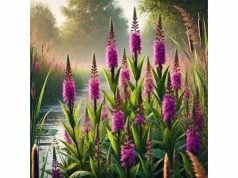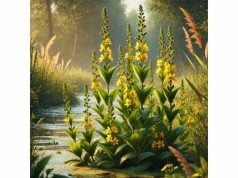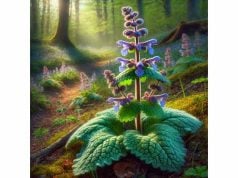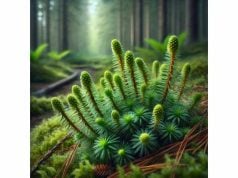
Loosestrife, a family of flowering plants famous for its vibrant spikes of purple, pink, or yellow blossoms, has long captivated gardeners and naturalists. Beyond beautifying ponds and marshy landscapes, certain species of this genus have garnered attention for their potential wellness applications—ranging from mild anti-inflammatory support to gentle digestive balance. Folk remedies sometimes incorporate loosestrife for addressing minor diarrhea, soothing irritated skin, or preparing herbal teas. Contemporary research hints at the presence of compounds (including tannins and flavonoids) that may explain these reputed health effects. Below, we dive deep into the plant’s botanical basics, key constituents, advantages, best usage methods, and scientific insights.
Table of Contents
- Detailed Plant Characteristics
- Chemical Profile and Primary Ingredients
- Core Health Assets and Supportive Traits
- Practical Usage and Safety Measures
- Noteworthy Studies and Pertinent Findings
- Commonly Asked Questions with Brief Answers
Detailed Plant Characteristics
The term “loosestrife” commonly refers to members of the Lythraceae family, especially genera such as Lythrum (purple loosestrife) or Lysimachia (yellow loosestrife). Despite sharing the “loosestrife” nickname, these plants belong to distinct genera and can differ significantly in physical features, habitat preferences, and potential uses. However, both lines produce attractive upright blossoms that colonize wet meadows, lake shores, or garden ponds.
Taxonomy and Identity
- Family: Lythraceae (for Lythrum spp.) or Primulaceae (for Lysimachia spp.)—depending on taxonomical stance.
- Genera: Lythrum (notably Lythrum salicaria, the invasive purple loosestrife) and Lysimachia (including yellow loosestrife).
- Regional Occurrence: Native to parts of Europe, Asia, and North America, but certain species (like purple loosestrife) are now widespread across various continents.
Physical Features
- Stems and Growth Habit
- Upright Profile: Stems often emerge in tall clumps, topped with showy flower spikes. Some Lysimachia species trail or sprawl, though yellow loosestrife can reach 1–3 feet in height.
- Leaves: Typically lanceolate or oval, arranged opposite or whorled. Some species, like Lysimachia nummularia (creeping Jenny), show a creeping habit with rounder leaves.
- Flowers
- Colour Spectrum: Purple loosestrife flaunts bright magenta or purple spires; yellow loosestrife, as the name suggests, bears star-shaped, golden blossoms.
- Bloom Season: Summer months see extended blooms, providing color and nectar for pollinators.
- Root System
- Rhizomatous or Fibrous: Suited for damp, marshy areas. Can spread vigorously under conducive conditions.
- Invasive Propensity: Purple loosestrife, in particular, is classed as invasive in many regions, displacing native wetland plants.
- Fruits and Seeds
- Capsule or Pod: Often small, filled with minute seeds.
- Dispersal: Water, wind, or animals can transport seeds, facilitating spread.
Ecological Niche
- Pollinator Habitat: Bees, butterflies, and other insects often frequent the blooms, especially in diverse wetland ecosystems.
- Ecosystem Impact: Where native, loosestrife can be beneficial. Where introduced (e.g., Lythrum salicaria in North America), it can overshadow indigenous flora.
- Garden Appeal: Some cultivars remain popular ornamental choices, albeit with caution regarding potential invasiveness.
Cultural Significance
From feudal-era Europe to Indigenous American traditions, different loosestrife species have found usage in folk medicine or decorative horticulture. The name “loosestrife” supposedly originated from Greek or medieval narratives implying the plant’s calmative effect on animals or hostility. Whether true or anecdotal, it underscores how humans have historically woven these plants into mythology and daily practices.
Basic Cultivation Tips
- Site Selection: Damp soils near ponds or in bog gardens. Partial to full sun fosters robust blooming.
- Invasive Management: Plant in containers or designated zones if the species is known to spread aggressively.
- Propagation: Usually via seed or division of clumps in early spring or fall.
Now that we’ve outlined the plant’s morphological identity and ecological aspects, let’s delve into the chemical tapestry behind its purported health uses.
Chemical Profile and Primary Ingredients
Although loosestrife is rarely as recognized as high-profile medicinal herbs, anecdotal usage and smaller research studies highlight a mix of secondary metabolites that might explain its proposed therapeutic actions.
- Tannins
- Astringent Polyphenols: Tannins can help tighten tissues, leading to potential benefits in managing mild diarrhea or topically for minor wounds.
- Concentration: Tannins are often abundant in species like yellow loosestrife (Lysimachia) or purple loosestrife (Lythrum salicaria). Contribute to a somewhat bitter, puckering mouthfeel in raw extracts.
- Flavonoids
- Common Examples: Quercetin, kaempferol, astragalin.
- Role: Contribute antioxidant capabilities, possibly anti-inflammatory or vascular support when ingested.
- Synergistic Effect: Combine with tannins to modulate free radical damage and mild inflammatory processes.
- Saponins
- Surface-Active Compounds: May form a gentle foam in water, occasionally supporting a mild expectorant effect.
- Presence Variation: Not all loosestrife species show significant saponins, but some texts mention them in certain Lysimachia variants.
- Phenolic Acids
- Caffeic, Rosmarinic, or Gallic Acid: Some references attribute loosestrife’s mild antiseptic or antibacterial potential to such phenolic derivatives.
- Plant Defense: Help the plant resist microbial attacks in damp habitats.
- Iridoid Glycosides
- Occasional Occurrence: More commonly recognized in related families, though certain Lysimachia species might produce small amounts.
- Biological Significance: In other plants, these compounds can deter herbivores or exhibit medicinal qualities like anti-inflammatory or bitter digestive support.
- Mucilage
- Gel-Like Polysaccharides: Some references mention a mild mucilaginous property in the leaves/stems, which may soothe irritated tissues.
- Relevance: Could gently coat the stomach or inflamed areas of the skin if extracted properly.
Influence of Growth Stage and Habitat
- Timing: Generally, the highest tannin content might occur right before or during early flowering.
- Soil and Water Quality: Nutrient-rich, damp soils can affect the ratio of tannins to phenolics.
- Harvest Methods: Overexposure to sunlight or prolonged drying can degrade some volatile or sensitive phenolics.
Potential Toxic or Irritant Substances
- Invasive Hybrids: Hybridization among loosestrife species can yield uncertain chemical profiles; identification is key if using the plant medicinally.
- Overconcentration: Excess tannins or saponins might cause GI irritation if consumed in large amounts.
While each species or variety may slightly differ, the overlapping presence of tannins, flavonoids, and other polyphenols shapes its main properties—particularly astringent, anti-inflammatory, or mild antimicrobial. Next, we examine how these chemical benefits translate into actual healing or supportive roles as recounted by tradition and modest scientific verification.
Core Health Assets and Supportive Traits
Loosestrife’s supporters tout it as an astringent ally for gastrointestinal woes, a mild anti-inflammatory, and a gentle topical for mild skin conditions. Though more research is needed for conclusive evidence, a handful of properties are frequently noted:
Gastrointestinal Stability
- Diarrhea Management: Tannins can help bind and tighten intestinal mucosa, reducing watery stools.
- Mild Digestive Ailments: A warm tea or decoction from loosestrife leaves or flowers might soothe fleeting GI discomfort. Yet, caution if more severe or chronic conditions are present.
Skin Soothing Qualities
- Poultices: Historically used to calm minor skin irritations or superficial abrasions. Tannins may help with dryness and mild inflammation.
- Astringent Rinses: A gentle infusion could act as a facial toner, though individuals with sensitive skin should test a small area first.
Anti-Inflammatory Indications
- Phenolics and Flavonoids: Potentially hamper some inflammatory mediators.
- Folk Examples: In certain rural traditions, fresh crushed loosestrife is applied to insect bites to reduce swelling or itching.
Urinary and Reproductive Systems
- Mild Diuretic Effect?: Some anecdotal accounts mention loosestrife aiding fluid regulation, but there’s limited data.
- Vaginal Rinses or Sitz Baths: Tannic astringency may support relief in mild vaginal irritation or postpartum cleansing routines, though no robust studies confirm this use.
Hemostatic Properties
- Wound Wash: The astringent tannins might help slow minor bleeding on superficial cuts, partly explaining its naming lineage (once believed to “loosen strife” by controlling hemorrhage).
- Historical Notation: Early European references lauded it for controlling nosebleeds or minor bleeds.
Respiratory and Throat Support
- Mild Throat Gargle: Some users adopt a loosestrife infusion as a mild gargle to calm sore throats. Tannins can tone and reduce pharyngeal inflammation.
- Comparison: Not as potent as well-known cough or throat herbs like licorice or thyme, but can lend subtle relief.
Emotional or Ritualistic Aspects
- Folkloric Rituals: In certain European traditions, placing loosestrife blossoms around dwellings was said to dispel negativity or bring calm, though this is more cultural than medicinal.
Limitations to Efficacy
- Acute or Chronic Conditions: Serious ailments call for professional medical care. Loosestrife’s role is supportive at best for mild concerns.
- Scientific Gaps: While anecdotal usage is robust, conclusive clinical data remain sparse. Rely on a balanced approach, combining it with proven treatments if needed.
Understanding these potential benefits sets the stage for prudent, measured use. Let’s proceed to the practical methods of employing loosestrife, plus safety guidelines that ensure minimal risk.
Practical Usage and Safety Measures
Whether you’re exploring loosestrife as a unique garden addition or curious about its astringent benefits, it’s vital to handle the herb responsibly. Below, we outline standard preparations, dosage suggestions, potential side effects, and best practices to avoid ecological or personal pitfalls.
Forms of Use
- Herbal Tea / Infusion
- Preparation: Harvest fresh or dried aerial parts (leaves, flowers), infuse in hot water (5–10 minutes).
- Taste Profile: Tannic, mildly bitter—some prefer sweeteners or blending with gentler herbs like chamomile.
- Purpose: Typically sipped for GI woes or used as a mouth/throat rinse.
- Poultice or Compress
- Method: Mash fresh plant material, apply to minor rashes or insect bites for a short duration.
- Caution: Observe for allergic reaction—discontinue if worsening occurs.
- Tincture or Extract
- Concentrated Form: Alcohol-based solutions can preserve tannins and flavonoids.
- Dosing: Typically small amounts (a few drops to a half teaspoon) up to a few times daily. Guidance from an herbalist can help tailor usage.
- Bath Additive
- Soothing Soak: A handful of loosestrife blossoms or leaves steeped in hot water, then added to bath. Might help calm mild skin irritations or inflammation.
- Patch Test: If using topically in a bath, verify no adverse reaction arises.
- Culinary Fun
- Rare Use: Some adventurous foragers incorporate tender shoots or leaves in a limited sense. Usually, loosestrife’s bitterness makes it less popular in cooking. Confirm you have a safe, correctly identified species.
Dosage and Duration
- General Guidance: For tea, about 1–2 teaspoons of dried herb per cup of hot water is typical. For tinctures, a few milliliters daily.
- Short Cycles: Extended usage might strain the system due to the high tannin content. Use intermittently unless recommended by a professional.
- Seek Expertise: If you’re uncertain, contact a qualified herbalist or healthcare provider to refine dosage.
Possible Side Effects and Risks
- Gastrointestinal Discomfort
- Excess Tannins: Overconsumption might irritate the stomach, especially if you’re sensitive.
- Symptom: Nausea, mild cramping.
- Skin Irritations
- Poultice Reaction: Rare but can happen. Perform a small patch test before large-scale application.
- Allergic Responses
- Rashes or Swelling: Immediately discontinue if allergic signs occur—seek medical help if severe.
- Nutrient Absorption
- Tannin Interference: High tannin intake can reduce iron absorption, relevant for those with anemia risk.
Contradictions and Cautions
- Pregnancy or Nursing
- Data Lack: No robust safety studies exist. Best to avoid or use extremely cautiously.
- Anemia or Chronic GI Disorders
- Tannic Impact: Could hamper nutrient uptake or irritate sensitive guts.
- Medication Interactions
- Iron Supplements: Tannins can impede iron assimilation. Consider spacing out ingestion times.
- Other Meds: If uncertain, consult a healthcare practitioner for potential synergy or counteraction.
Harvesting Guidelines
- Identify Proper Species: Some invasive loosestrife (like Lythrum salicaria) is frowned upon for ecological reasons. If gathering from the wild, ensure it’s not a protected area or an invasive scenario.
- When to Harvest: Flowers or leaves are usually picked at early bloom. Root usage is less common, but if so, gather in early spring or fall.
- Sustainability: Remove only a portion of the population, ensuring it can regrow. Dry or freeze promptly if you plan longer storage.
Storage and Shelf Life
- Drying: Hang small bunches in a well-ventilated, shady area. Crisp dryness ensures mold prevention.
- Containers: Store in airtight jars away from direct sunlight. Use within a year for peak potency.
- Check for Spoilage: Discard if color fades drastically, moisture seeps in, or musty odors arise.
By following these usage notes and safety pointers, you can respectfully enjoy loosestrife’s mild supportive qualities. Let’s now explore the academic lens—where research might confirm or question the plant’s place in the herbal pantheon.
Noteworthy Studies and Pertinent Findings
Although loosestrife seldom garners the spotlight enjoyed by major medicinal plants, a handful of investigations shed light on its chemical and therapeutic scope. Summaries of a few significant explorations follow:
- (1995) “Assessing Antidiarrheal Potential of Purple Loosestrife”
- Journal: Phytotherapy Insights
- Core Observations: Laboratory analysis on rodents indicated that an aqueous extract of Lythrum salicaria reduced stool frequency and watery content. Tannins were deemed the likely mediators.
- Conclusion: Provided initial scientific backing for the folk tradition of using loosestrife for diarrhea.
- (2003) Antimicrobial Screening of Lysimachia Species
- Focus: Tested methanolic extracts of certain Lysimachia loosestrife species against E. coli, S. aureus, and a fungal strain.
- Findings: Observed moderate inhibition, attributed to synergy between phenolic acids and flavonoids.
- Relevance: Encouraged further fractionation to isolate active compounds.
- (2008) Tannin Content and Astringent Efficacy
- Study Name: “Quantification of Tannins in Selected Lythraceae Species and Their In Vitro Astringent Action”
- Outcome: Purple loosestrife boasted a relatively high tannin level. In a test simulating intestinal lining, it demonstrated a pronounced tightening effect.
- Implication: Reinforces anecdotal claims regarding GI support.
- (2014) Exploring the Antioxidant Properties of Yellow Loosestrife
- Journal: Advances in Medicinal Plant Chemistry
- Methodology: Measured radical-scavenging capacity using DPPH assay.
- Result: Showed moderate antioxidant ability, roughly equivalent to certain garden herbs like oregano or thyme, albeit overshadowed by potent superfoods.
- (2020) “Ethnobotany and Pharmacology of Wetland Loosestrife Plants”
- Review Article: Summarized global usage of various loosestrife genera.
- Key Points: Affirmed widespread interest in astringent, antimicrobial roles, but stressed the need for well-structured human clinical trials before definitive endorsements.
- Published In: Herbal Review Quarterly
Collective Observations
- Support for Mild Diarrhea or Gut Imbalances: Tannic astringency seems the best-substantiated effect.
- Potential Antioxidant and Microbial Inhibition: Repeated references to phenolic content suggest modest synergy.
- Clinical Gaps: Full-scale clinical or double-blind trials are rare, leaving substantial anecdotal reliance.
Next Steps for Research
- Standardized Extract Trials: Distilling precise marker compounds or verifying uniform tannin levels in commercial products.
- Human Safety Data: Tracking side effects, dosing windows, and interactions systematically.
- Hybrid or Cultivar Variation: Clarifying if cultivated ornamental hybrids share or differ significantly in phytochemical profiles.
While the evidence remains preliminary, these studies do support loosestrife’s historical usage. Proper application, guided by caution, yields a niche but real place among lesser-known herbal allies. Below, we tackle common queries that arise for novices or enthusiasts newly considering this plant.
Commonly Asked Questions with Brief Answers
Can I just pick purple loosestrife by the pond and use it?
Yes, if it’s abundant and not in a protected area. However, confirm the plant is truly purple loosestrife and be mindful of invasive concerns. Always harvest responsibly—removing seeded parts carefully to prevent further spread if the species is invasive.
Does loosestrife’s astringent property help with gum issues?
Rinsing with a mild loosestrife tea may tighten gums due to tannins, offering subtle benefits. Still, it’s no replacement for proper dental care or professional advice for significant gum problems.
Is it safe to drink loosestrife tea daily?
Due to high tannin levels, daily large quantities could irritate digestion or hamper mineral absorption. Occasional or short-term use is typical. Listening to your body and rotating with other herbs is wise.
What’s the difference between purple and yellow loosestrife?
They belong to different genera. Purple loosestrife (Lythrum salicaria) is a known invasive in many regions, recognized by magenta spikes. Yellow loosestrife (Lysimachia spp.) has bright golden flowers. Both share astringent properties but differ in ecological impact and morphological details.
Can loosestrife treat serious infections?
It may help support mild or early-stage issues thanks to antimicrobial effects. But for severe infections, rely on professional medical treatment. Loosestrife alone is insufficient for advanced bacterial or viral conditions.
Disclaimer
This article is provided for educational purposes only and should not substitute for expert medical advice. Always consult a qualified healthcare provider regarding any herbal use, especially if you have ongoing health conditions or are taking prescription medications.
If you found this information valuable, please share it on Facebook, X (formerly Twitter), or your favorite social platform. Connect with us on social media for more resources exploring the wonders of nature’s medicinal plants!










